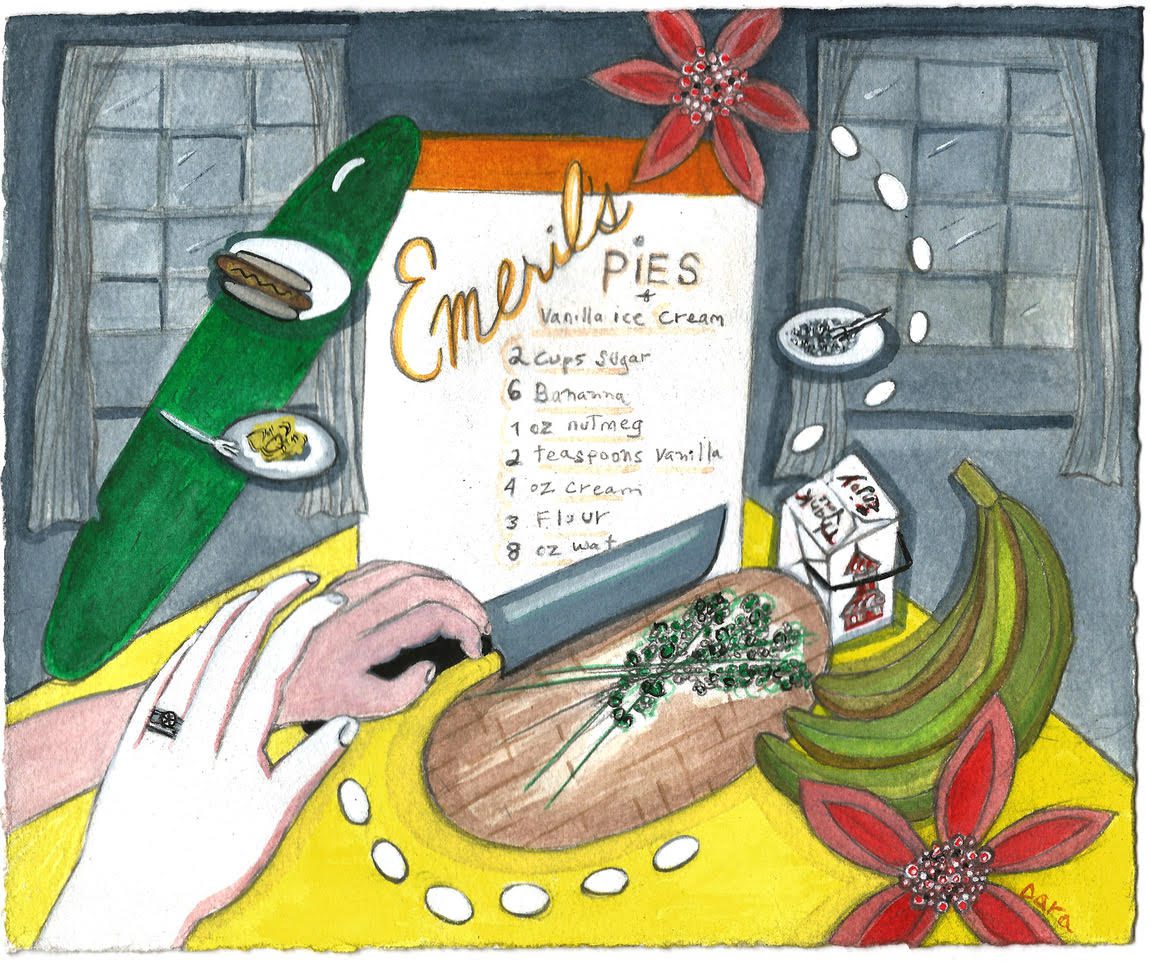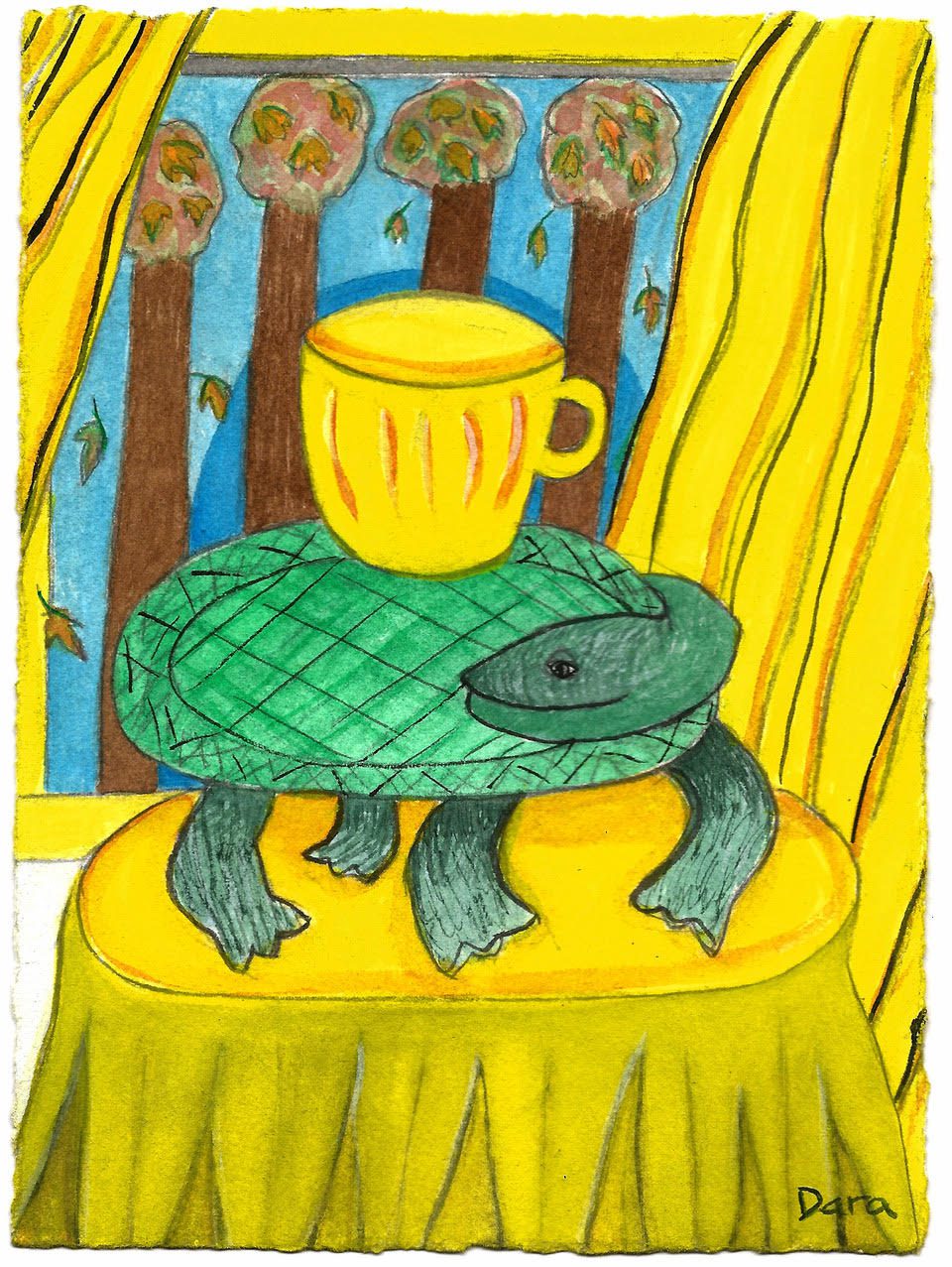
My nine-year-old son, Rudy, announces a desire to try turtle soup. It’s summer and he’s home for the duration. For a variety of reasons, we are not doing camp, so instead my husband and I are tag-teaming childcare and struggling to come up with fun/educational projects to keep all of us from climbing walls. For my part, I am teaching my son how to cook. It was his idea actually. At the library, we found a ‘90s Emeril Lagasse cookbook written for kids. He snapped it right up. So far, we’ve made Portuguese rice, Jamaican jerked chicken, BLT hot dogs with pan bagnat, and Caribbean roasted bananas, sticky sweet and caramelized with vanilla ice cream. He is learning to read a recipe, learning to read it all the way through before beginning to cook—something I have promptly forgotten to do twice during this project, despite having just schooled him on its importance.
We talk about the difference between the careful, devoted adherence to what’s written and the pleasure (and sometimes peril) of “just winging it.” I’ve been telling him stories about the people who taught me, variously, how to cook: my mother, my grandfather, my first mother-in-law whom we refer to as Meema. I use her as an example of strict adherence taken to an extreme. “We don’t have cilantro for this dish, but that’s okay,” I tell him. “We’ll just use parsley. Though if Meema were cooking this and realized she’d grabbed the wrong green herb, she’d abandon ship and order Chinese takeout.” We laugh and chop the cilantro with the eight-inch chef’s knife, my hand on top of his for the first few, sure strokes, then off. I feel a little bad using my former mother-in-law as a cautionary tale like this. There’s nothing wrong with following a recipe, I say, but I want him to trust that he can improvise if and when it comes to it, too.
I love cooking with Rudy. This has been the highlight of my summer so far. I am not great at structure with my family, not awesome at planning our long days together at home. I imagine other families, those better families, with their “staycations” or their “stay-at-home-camp” days: 8 a.m., organic, locally sourced breakfast; 9 a.m., organic gardening; 10 a.m., sun-hatted and slathered with SPF 70, hiking through the park before the blunt heat of day. On and on like this through the day, the weeks, the whole summer, in one-hour chunks of parent-driven enrichment. I have not pulled this off. I am either in my pajamas (and them, too) writing or answering work emails until 10 a.m., or else in my actual campus office while my husband, Paul, plays endless rounds of Mancala, Sorry!, and Monopoly with Rudy and his younger sister, Josie
But cooking I can do. The planning of it is pure joy for me. I love telling Rudy stories about my own first experiences in the kitchen, making scrambled eggs with my mother, or my first fine-dining meals—like the turtle soup he’s heard me talk about and now says he wants to try—with my father. I also love that he seems drawn, as I am, to world cuisine and to challenging ingredients. I’m amazed that at this young age he appears game for almost anything.
In grad school I had a friend who said he wished that food could be taken through an IV or, better, a one-time injection. Nothing about the experience of eating brought him pleasure or joy. The entire process of shopping, preparing, and ingesting food stole valuable time from other things he wanted to do. His girlfriend and I would cook meals together in their tiny galley kitchen—roasted salmon, wild rice soup, Italian dishes that called for more garlic than seemed prudent. He ate and thanked us but never joined in our ecstatic feasting.
At seven, my daughter, Josie, has some of this. With the exception of sweets, her relationship to food is one of ambivalence at best, skepticism and disgust at worst. We used to say when she was a toddler that she subsisted on dust motes floating in sunbeams. Later, she will come to love pork soup dumplings at the Taiwanese noodle shop in our Squirrel Hill neighborhood and will ask me to teach her how to make scrambled eggs—the first recipe I ever learned from my mother. She will come home from third grade with a recipe for cucumber salad she learned from Farmer Tim, the instructor for the school’s edible garden project. She will take great pride in her ability to execute both of these dishes by herself. “You don’t have to hold my hand, Mama!” she will say when I try to guide the knife in her small hand. “Just tell me how to do it.” Things with Josie get done in Josie’s way and to Josie’s own tastes: eggs cooked until they are a little dry, big chunks of crisp English cucumber doused with three times the amount of rice vinegar the recipe calls for. For now, though, she wants nothing to do with cooking and would happily exist on Double Stuf Oreos if we let her.
Sitting at the dining room table this morning, I sipped coffee out of my favorite yellow mug—the same yellow as the dining room curtains and the tablecloth, now pulled aside to let the light fall through—and I explained to Rudy that making true turtle soup might be difficult, given the illegality of turtle meat in some areas, but we can make a mock version. He asks how. I show him a recipe that includes the boiling of a whole calf’s head plus brains. “Sure!” he says. “Absolutely. Let’s do it.” I feel a thrill of electricity and possibility. A powerful surge of nostalgia. Yes, let’s do it! I make a mental note to ask my local foodie friends where, in Pittsburgh, I might source calves’ brains, though in truth I’m not sure I could bring myself to prepare them.
The next day, I make fried cod for dinner and despite my exuberance for the dish (crispy, not greasy, served with a cabbage and apple coleslaw I know he would love) he will not touch it. I say, “You’ll eat brains but not fried fish? You know you’re a little weird, right?”
“I’m not weird, Mama,” he corrects. “I’m complicated.”
It doesn’t feel weird at all to be cooking with Rudy. Rather, it feels easy and pleasant and wonderful. But it does feel complicated.
I have been writing about my father and food since his death in 1992, when I was a senior in college. I have cultivated a large part of my identity around this eating, the conflation of his life-in-food with my own, and with the memory of meals eaten at his direction, in his presence, or his memory. Between my father and me, food was a shared language that stood in for other, more explicit modes of affection. It was also a site of great optimism (if I eat this, I’ll prove my worldliness, my mettle), and anxiety (if I decline, I will disappoint him, will lose his loving attention). And now, almost twenty-two years after his death, I have this son, who never met him, who seems to be following in his foodie footsteps. But is he? Is he really? Or did I will this into being? Did I, am I, mapping this love of food—my love of food and all its complicated history—onto my son?
It’s not as if I have a lot of evidence to present or ponder here. Rudy is only nine. Still, there was his Oma’s guacamole, studded with fresh jalapeños, which he gobbled up at his first birthday party. There were the raw red onions he snatched off the falafel plate when he was three. There was the entire jar of chapulines—roasted, spiced grasshoppers—our friends brought back from their Oaxaca honeymoon. They were meant to be a joke, but when we unscrewed the lid and offered them, he grabbed them by the fistful, crunching happily and coming back for more. He had just turned four.
A few weeks ago, our family marked our one-year anniversary of living in Pittsburgh. To celebrate, we went out to dinner at a restaurant that overlooks Schenley Plaza. As always, we tried to find one that has a menu with enough variety to satisfy us all. For Josie, that means a cheeseburger. For Rudy, Caesar salad with crunchy croutons. Paul and I, craving a beach vacation that is just not within our reach this year, ordered oysters on the half shell as an appetizer. Six perfect, succulent mollusks arrived at the table, iced and glistening in their liquor, snuggled next to cocktail and mignonette sauce. Lemon wedges begging to be squeezed. Our favorite treat! Three each, I thought.
“Can I try one?”
Rudy stared at me from over his Caesar salad, and I honestly felt a proprietary pang: These are my oysters! Get your own, kid. But then, I remembered the vow I made to my father so many years earlier, which I have adapted slightly for my children: Try everything at least once. If they ask, when they ask, to eat whatever it may be (Fruity Pebbles; jalapeño chili dogs; precious oysters, quaveringly alive), I will always say yes.
“Do you want me to show you how to eat them?” I asked.
“No, I think I can do it.”
I watched as he mimicked my motions, spooning a small drop of the vinegary sauce onto the shivering muscle, tipping the shell toward his lips. Swallowing. He’s a quick study, my son. I watched for his face to shift into delight or horror, but he remained implacable. Only his eyes exclaimed.
“Well? What do you think?”
“Good. Can I have another?”
I traded him the rest of my share for his wilted salad. He slurped one and then another and then the shells were empty, the tray cleared away by the waiter to make room for the entree, whatever it was.
Later, he told me he had only eaten the oysters to make me happy. I was a little disappointed but not surprised. They are a challenging food. Paul says whoever it was that first ate a raw oyster must have been very, very hungry.
Already, at nine, my son knows that eating makes me happy. And he knows that sharing this experience with him in particular makes me especially happy. He’s learned exactly the lesson my father’s delights taught me. I don’t want to push him the way my father would have pushed me. I don’t want to make him feel like his refusal of food is a refusal of my love or affection. Every book I’ve read on feeding children implores parents not to “make food a battleground.” So I try to respond as neutrally as possible.
“No biggie, sweetie. It’s great you tried it. Let’s go see what Daddy’s up to outside.”
The local foodies come through with the info we need: Strip District Meats is our best bet for finding both calf brains and, it turns out, turtle meat. We’ve been to the Strip a couple of times with the kids already. While originally an industrial neighborhood, produce merchants and wholesalers took over in the early twentieth century and now it’s a vibrant space for commerce of many kinds, but still mostly food. My children associate it specifically with the old-timey candy shop that plays the original Willy Wonka movie from the 1970s—the one I grew up with—on a screen in the back. Today, Josie has the hardest time choosing. She wants the foot-long Pixie Stix, but we steer her toward more temperate treats. This is a bribe; she has no interest whatsoever in the butcher shop we’ve trekked down here to find. She ends up with a small roll of Sweet Tarts, her brother with a package of Gummi Bears. We cross the street and head up the block to find the storefront.
It’s Saturday, so the place is packed. I squeeze past customers leaving with packages wrapped in brown paper, into the narrow aisle between two long refrigerator coolers filled with meat, made even narrower by the crowd. I think the kids and Paul are behind me, but I’m not sure. I trust that they are and try to focus on the fleshy bounty to my right and left. There is every possible cut from every animal you usually associate with dinner (hamburger, whole fryer chickens, bacon) and those you might need for something a little more out of the ordinary (duck gizzards, beef tongue, hog maw). I scan the chalkboard menu carefully, but cannot find turtle meat. I’m starting to think more practically about calf brains for this soup—or maybe oxtails would work—when I see that Rudy has actually gotten past me and is now motioning from what looks like an alcove in the back of the store. My first instinct is to chastise him for wandering into an employees-only area, but then I see the freezers and the sign that says “Exotic Meats.” Okay!
“Rattlesnake! Camel! Woah, Mama, can we get some kangaroo?” Rudy reads the white labels on the boxes to me and I’m astounded.
I’d assumed Pittsburgh to be a meat-and-potatoes town, maybe a kielbasa and cabbage town, but clearly there are enough adventurous eaters in our new city to warrant an entire freezer of surprise protein. Who buys this stuff? The chefs who are responsible for the city’s increasingly national food scene? I’m sure I’ve never seen camel on the menu anywhere, and I’m not sure I’d order it if even if I did. I can hear in my son’s excitement both my father’s influence and disappointment in me: What do you mean you wouldn’t order it? We had a deal, remember? You promised to try everything. Or, more likely, he would have ordered for both of us and then fed me the camel from his plate.
In the end we leave with a pound of frozen turtle meat and nothing else, simply because I am so overwhelmed by the masses of people and the endless options. We walk back up Penn Ave. to the car, and Rudy seems excited. He asks me what other ingredients we need and I tell him I’ll have to look up a recipe when we get home. Josie is positively horrified by the idea of turtle soup. She doesn’t even want us to discuss it in front of her. Plus, she has an incredibly acute and easily offended sense of smell. I know that when I serve the soup that her brother and I will make, she will eat a peanut butter and Nutella sandwich, probably in another room.
If someone asked me about the most memorable meal I ever had with my father, I would likely say it was the one we shared on the college-visit trip to Philadelphia when I was seventeen. I would describe the fancy dining room, the candles, the turtle soup he ordered for us, and the warming sherry he taught me to add to the bowl. I would tell, again, the story of how he unexpectedly loosened up his normally serious and reserved persona on that trip, listening to pop and rock music on the drive and singing karaoke to embarrass and delight me at the piano bar after dinner. The taste of that soup has become rarified through time and memory and loss; I remember it as rich and hearty. I remember the meat as soft as braised beef and my father with a real smile on his face. How we enjoyed one another. It has been an iconic mouthful, a favorite memory of mine for twenty-five years.
In the kitchen, Rudy chops the mirepoix and I make the roux. After a while, it’s time to eat. We sit down at the table, the bright yellow cloth lighting up the room. I feel happy. This cooking together has been delicious, but the soup itself tastes, if I’m honest, just okay. Maybe even slightly less than okay. The stew broth is thick and flavorful, but the meat—I could tell when I defrosted it—is very lean and sinewy and has a rather unpleasant rubbery chew to it. I hate to admit this, but I have to kind of choke it down with a lot of water—a technique Paul developed as a child when he was trying to break free from an unpalatable dinner quickly. Inelegant but effective. I try not to let on my disappointment, though I can tell that Rudy and Paul aren’t enjoying it either. I want the spell to last, the circuit between generations to stay live a little longer.
With Josie in the living room, happily enjoying a bowl of Kraft Easy Mac and an episode of SpongeBob SquarePants, the rest of us each finish one bowl of turtle soup. While we do, I resist the urge to tell stories about my father. It’s not easy. My instinct is to narrate, to fill in what I imagine to be missing. So much is missing. Years and years of meals my father might have shared with me and my children just for starters. But I keep my longing to myself this time. Maybe this uncharacteristic restraint will become part of Rudy’s turtle soup story—if he has one—much the way my father’s uncharacteristic openness was part of mine.
After dinner, I put the leftover soup into a container in the refrigerator. Maybe, I explain to Rudy as we clean up the dishes, it will improve over time, the way some soups do.
***
Rumpus original art by Dara Herman Zierlein.







